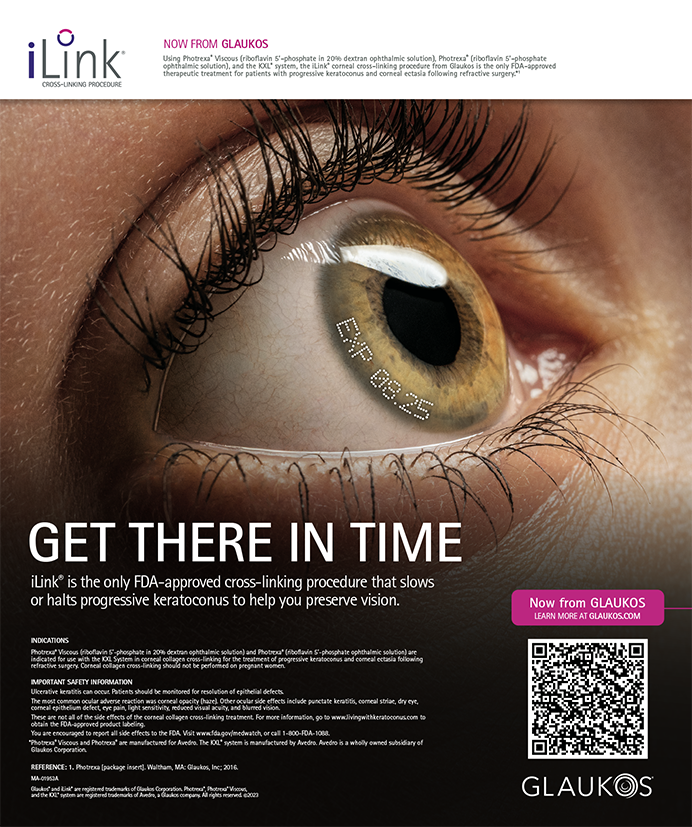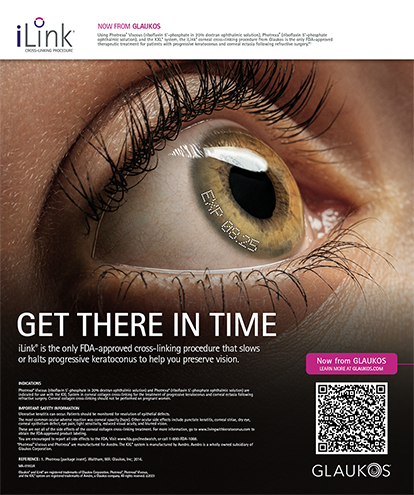Now that presbyopia-correcting IOLs are available, every cataract patient is potentially a refractive patient, even those who present for so-called routine cataract surgery. All cataract patients should be offered the opportunity to receive a presbyopia-correcting IOL. They may not have a lot of interest in this technology or know much about it, but educating patients does not take much time and is necessary so that they may make an informed decision. Anecdotally, after I first started implanting these lenses, there was a discussion in the waiting room of our clinic between a patient of mine who had received this type of lens and a patient of one of my partners who had not and had not been made aware of the option. Upon learning about my patient's presbyopia-correcting IOLs, my partner's patient was angry about not having been informed about them. The issue is patient choice. Whether they want it, do not want it, or are unable to afford it, we surgeons should make the option available to all patients and let them decide.
WHO IS A CANDIDATE?
Many patients go to an ophthalmologist because they think they want corneal refractive surgery, but they find out that they may be better candidates for lenticular refractive surgery, whether refractive lens exchange or another form. In particular, high hyperopes or hyperopes who are in the prepresbyopic or presbyopic age range are ideal patients for a presbyopia-correcting IOL procedure, and they need to become aware of all the alternatives available to them. More often than not, hyperopes opt for presbyopia-correcting IOLs because they want independence from glasses and contacts (that desire is what brought them in initially). To tell these patients that you can perform a corneal refractive procedure for them but that afterward they will still need glasses to read makes them second-guess such a surgery. Presbyopia-correcting lenses will give them the dual benefit of an improved range of vision without spectacle dependence.
CHANGES IN MY SURGICAL ROUTINE
Presbyopia-correcting IOLs have changed the way my staff and I conduct initial screenings of our cataract patients. Now, all of the patients my staff schedules for cataract surgery receive a brief discussion about this technology's potential to give them good near and distance vision without glasses and are asked if that is something that they would desire. If they answer yes, then we go into more detail. If they answer no, then we switch to talking about conventional IOL cataract surgery.
Our discussions with patients about presbyopia-correcting IOLs are very frank, because refractive cataract patients' expectations are high. We are explicit in terms of what presbyopia-correcting IOLs can and cannot do and the upsides and downsides of each lens. We have this conversation with patients before their preoperative workup. By the time they return from their workup, most have decided that they want this procedure.
REFRACTIVE LENS EXCHANGE
There is significant controversy about performing refractive lens exchange in myopes because of the increased possibility of retinal detachment. This legitimate risk must be discussed with candidates. Kerry Solomon, MD,1 and Emanual Rosen, MD,2 conducted meta-analyses on the risk factors for retinal detachment in myopic patients. Both showed that young males under the age of 45 with axial lengths of >25mm are at the highest risk for this complication and therefore are relatively contraindicated for refractive lens exchange. However, if these factors are not present and the patient's myopia is less than 7.00D, the risk of retinal detachment is no higher than for the general population, and he or she becomes a potential candidate.
The patients that have been the most difficult to please in my experience with presbyopia-correcting lenses, regardless of the brand, are low myopes. These individuals are used to having excellent reading vision without glasses, and they may not be perfectly happy with the vision they receive from a presbyopia-correcting IOL. In short, if I were to divide patients into groups from the best to worst candidates for presbyopia-correcting IOLs, the best are the presbyopic hyperopes, followed by high hyperopes in general, then mid-range myopes, followed by presbyopic emmetropes, with low myopes being the most difficult to treat. High myopes, as I discussed, are contraindicated for this technology.
PREOPERATIVE ROUTINE
My clinical preoperative routine for presbyopic cataract patients is more extensive than for my routine cataract patients. The former receive a full array of tests, including corneal topography, pachymetry, immersion A-scan and IOLMaster A-scan (Carl Zeiss Meditec Inc., Dublin, CA). My staff and I then compare these two forms of biometry to make sure that their results are similar. If they are not, we repeat those tests until we achieved a strong correlation of the axial length. The key element to success with these lenses is to nail the correct lens power. If you are not accurate with your measurements, the patient will be dissatisfied, regardless of your surgical technique. We have our patients return on a separate day to undergo all preoperative tests, rather than squeeze them into the schedule on the day they visit. That way, patients have our full attention, and they know they are coming in for something special. To me, these are the two essentials for success with presbyopia-correcting IOLs: to nail emmetropia and to talk to the patient about realistic expectations.
Before we proceed with the surgery, there is one more important discussion to have with refractive cataract patients as part of setting their expectations. That is, no matter which presbyopia-correcting IOL we use, data from all three of the manufacturers' FDA clinical trials have shown that patients see better when both eyes are operated on rather than just one eye (data on file with Alcon Laboratories, Inc.; Advanced Medical Optics, Inc.; and Eyeonics, Inc.). So, we describe to patients what their vision may be like after they receive the first implant and stress that it may be poorer than they expect. We explain that only after they receive their second implant and go through a period of neural adaptation will their vision reach the expected targets. We stress that this process takes time.
Thus, patients enter their first surgery with the expectation of a less-than-perfect outcome. Too often, we hear of doctors who implanted a presbyopia-correcting IOL in the first eye, the patient was unhappy, and then either the physician or the patient is hesitant to proceed with the second surgery. If patients know ahead of time that their vision might be a bit blurry and disjointed until they receive the second implant, they remain motivated to undergo the second surgery as soon as possible.
POSTOPERATIVE FOLLOW-UP
Because refractive cataract patients often have many more questions postoperatively than traditional cataract patients, my staff and I usually schedule one or two more follow-up visits with them. We may conduct specific tests such as repeat topography to look for astigmatism, and of course we test their vision to see where they fall on the "happy scale," which is much more important than the eye chart visual acuity.
For the most part, my refractive cataract patients are meeting my targets, but I certainly discuss up front the potential for enhancements postoperatively. I personally charge a single price for the procedure and tell the patient that my team and I will do our best to achieve their best possible vision, regardless of what type of enhancement we may need to perform. So, if a patient needs LASIK, PRK, or AK after cataract surgery, the secondary procedure is included in the global cost of his or her initial surgery. I do not charge an extra out-of-pocket cost during the first year after refractive cataract surgery.
In cases where I know I will have to perform an enhancement, such as in patients with a high degree of astigmatism preoperatively, I tell them that the procedure will be staged. Some physicians raise a LASIK flap first, perform the cataract surgery, and then relift the flap for the corneal treatment so they do not have to put a microkeratome on the eye after lenticular surgery. This approach may minimize any complications and shorten the procedure to 3 to 4 weeks as opposed to the 2 to 3 months that it might take for cataract wounds to heal satisfactorily before placing a microkeratome's suction ring on the eye.
NOW IS THE TIME
There is a certain amount of confusion in the refractive cataract marketplace right now, because the different presbyopia-correcting lenses perform a little bit differently. I think it is important to gain experience with each one and to learn their pros and cons, because each of these lens technologies is valid and may be preferable in different patients. I advise ophthalmologists to become educated about these technologies and not sit on the sidelines and wait for one presbyopia-correcting lens to emerge as the winner, because I think each has its place. All have the potential to improve patients' quality of life, and the time to get into the game is now. Physicians who delay adopting this technology are going to be left behind. It becomes much more difficult to catch up later than to engage right now.
As far as I am concerned, there has never been a more exciting time in the field of cataract refractive surgery, because the options we have for our patients hold so much promise. Whether the choice is conventional cataract surgery, presbyopia-correcting lenses, phakic IOLs, toric IOLs, aspheric IOLs, LASIK, or combinations of these technologies, nearly every patient can gain improved vision. It is a fortunate time to be practicing, and ophthalmologists must become engaged to allow their patients access to these new technologies.
Stephen S. Lane, MD, is a clinical professor at the University of Minnesota in St. Paul. He is a consultant to Alcon Laboratories, Inc., Bausch & Lomb, Visiogen, Inc., and Visioncare Ophthalmic Technologies. Dr. Lane may be reached at (651) 275-3000; sslane@associatedeyecare.com.


